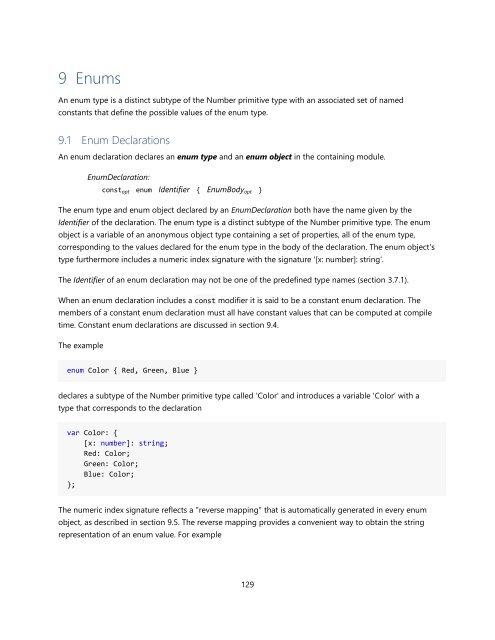TypeScript Language Specification v1.5
TypeScript Language Specification v1.5
TypeScript Language Specification v1.5
You also want an ePaper? Increase the reach of your titles
YUMPU automatically turns print PDFs into web optimized ePapers that Google loves.
9 Enums<br />
An enum type is a distinct subtype of the Number primitive type with an associated set of named<br />
constants that define the possible values of the enum type.<br />
9.1 Enum Declarations<br />
An enum declaration declares an enum type and an enum object in the containing module.<br />
EnumDeclaration:<br />
const opt enum Identifier { EnumBody opt }<br />
The enum type and enum object declared by an EnumDeclaration both have the name given by the<br />
Identifier of the declaration. The enum type is a distinct subtype of the Number primitive type. The enum<br />
object is a variable of an anonymous object type containing a set of properties, all of the enum type,<br />
corresponding to the values declared for the enum type in the body of the declaration. The enum object's<br />
type furthermore includes a numeric index signature with the signature '[x: number]: string'.<br />
The Identifier of an enum declaration may not be one of the predefined type names (section 3.7.1).<br />
When an enum declaration includes a const modifier it is said to be a constant enum declaration. The<br />
members of a constant enum declaration must all have constant values that can be computed at compile<br />
time. Constant enum declarations are discussed in section 9.4.<br />
The example<br />
enum Color { Red, Green, Blue }<br />
declares a subtype of the Number primitive type called 'Color' and introduces a variable 'Color' with a<br />
type that corresponds to the declaration<br />
var Color: {<br />
[x: number]: string;<br />
Red: Color;<br />
Green: Color;<br />
Blue: Color;<br />
};<br />
The numeric index signature reflects a "reverse mapping" that is automatically generated in every enum<br />
object, as described in section 9.5. The reverse mapping provides a convenient way to obtain the string<br />
representation of an enum value. For example<br />
129


















